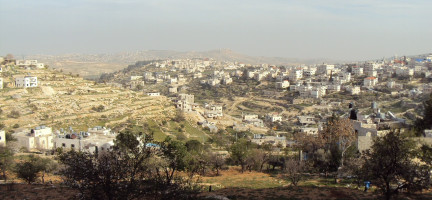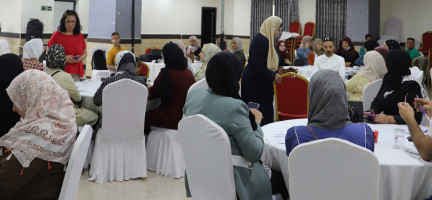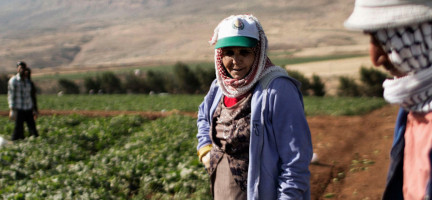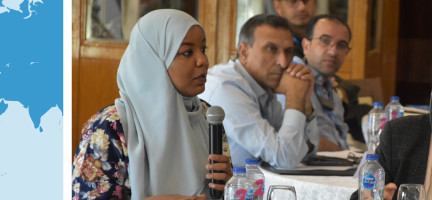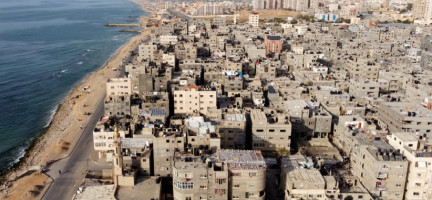فلسطين
دولة فلسطين أو الأرض الفلسطينية المحتلة (OPT) هي دولة تقع في غرب آسيا بين البحر الأبيض المتوسط ونهر الأردن والبحر الميت. تتكون الأراضي الفلسطينية من جيبين: الضفة الغربية وقطاع غزة. الضفة الغربية فيحدها الأردن من الشرق
يعتبر التقسيم المكاني والإداري داخل الضفة الغربية المحتلة بما فيها القدس الشرقية وبين الضفة الغربية وقطاع غزة التحدي الأكبر الذي يواجه المدن والمجتمعات الفلسطينية ( موئل الأمم المتحدة (2017) ملف دولة فلسطين. ). يلعب القطاع الزراعي الفلسطيني دوراً رئيسياً في النمو الاقتصادي للبلاد، فضلاً عن كونه أداة تمكينية للتنمية الاجتماعية والاستدامة البيئية. ومع ذلك، فإن القيود التي تفرضها إسرائيل على الأنشطة الاقتصادية والإنتاجية، بما في ذلك القيود المفروضة على حركة الأشخاص والبضائع، وعدم إمكانية الوصول إلى الأراضي والمياه والموارد الطبيعية الأخرى، تضعف بشدة الاقتصاد الفلسطيني وإمكاناته للنمو ( منظمة الأغذية والزراعة (2019) تحليل السياق لـ إطار البرمجة القطرية لفلسطين 2018-2022. ).
نظرة عامة على الوضع المتعلق بالأراضي في الأرض الفلسطينية المحتلة
حيازة الأراضي
لا تزال حيازات الأراضي في الضفة الغربية وقطاع غزة خاضعة لقانون الأراضي العثماني لعام 1858، بصيغته المعدلة والمطورة بموجب التشريعات التي صدرت في عهد النظام الأردني والانتداب البريطاني والإدارة المصرية والأوامر العسكرية الصادرة منذ الاحتلال الإسرائيلي . وفقًا للجنة تسوية الأراضي والمياه (LWSC)، فإن 38 في المائة فقط من الأراضي في الضفة الغربية مسجلة حاليًا، مع بقاء جزء كبير من العقارات غير المسجلة في المراكز الحضرية ( البنك الدولي (2019)، وثائق معلومات المشروع المجمعة / ورقة بيانات الضمانات المتكاملة (PID/ISDS). تمت الزيارة في 20 كانون الأول/ديسمبر 2021، بينما في قطاع غزة، أكثر من 90 بالمائة من الأراضي مسجلة بالفعل ( Obidat, U. (2018) محامون الفلسطينيون/ ملخص قانون الاراضي (٢) الجزء إنها والأخير.تمت الزيارة في 20 كانون الأول (ديسمبر) 2021، ). يتم تسجيل الأراضي في الأراضي الفلسطينية المحتلة من خلال التسجيل المنهجي للأراضي (SLR) والتسجيل الجديد. ومع ذلك، توقف تسجيل الأراضي بسبب حرب عام 1967، وتوقف تسجيل الأراضي المنهجي والتسجيل الجديد حتى إنشاء LWSC في عام 2016؛ ومنذ ذلك الحين، قامت هيئة تسوية الأراضي والمياه بزيادة نسبة استكمال تسوية الأراضي من 34 إلى 57 في المائة، مما سمح بزيادة تسجيل الأراضي (هيئة تسوية الأراضي والمياه (2022) البيانات الأولية).
قيمة الأراضي
في الضفة الغربية، يكمن أساس تقييم العقارات بشكل رئيسي في القانون الأردني رقم 11 لسنة 1954 "ضريبة المباني والأراضي في منطقة البلديات والمجالس المحلية" وتعديلاته، وفي قانون ضريبة الأراضي رقم 30 لسنة 1954. 1955 الذي فرض الضرائب على الأراضي الواقعة خارج حدود البلديات. أما في قطاع غزة، فإن أساس تقييم الممتلكات موجود في القانون رقم 42 لسنة 1940 "ضريبة الأملاك داخل المدن" الصادر عن المندوب السامي البريطاني في فلسطين؛ ويجري حاليًا تطوير نظام تقييم موحد.
استخدام الأراضي
تم تطوير نظام تصنيف استخدامات الأراضي الفلسطيني الحالي وفقاً لنظام تصنيف استخدامات الأراضي المعتمد من قبل اللجنة الاقتصادية لأوروبا (ECE) والذي يعتمد على الأساليب والمصادر المستخدمة لإنتاج بيانات استخدامات الأراضي، مثل السجلات الإدارية وتحليل البيانات الجوية وصور الأقمار الصناعية. إن الفئات المستخدمة في نظام التصنيف هذا هي تقريباً نفس فئات استخدامات الأراضي المتوفرة في الأراضي الفلسطينية المحتلة ( الجهاز المركزي للإحصاء الفلسطيني (2000)، نظام تصنيف استخدامات الأراضي الفلسطيني، ).
تطوير الأراضي
في عام 2015، أنشأت السلطة الفلسطينية، بدعم من برنامج الأمم المتحدة للمستوطنات البشرية وبرنامج الأمم المتحدة الإنمائي وشركاء التنمية الآخرين، الخطة المكانية الوطنية 2050 (NSP) التي تحدد رؤية طويلة المدى للتنمية الشاملة مع الاستخدام الأمثل للموارد المتاحة والمحتملة مع ضمان الأمن البيئي والتنمية المستدامة. تربط الخطة المكانية الوطنية بين التخطيط المكاني والتنموي وتلتقط إطار منظور واسع: الاقتصاد والتنمية الحضرية والبنية التحتية والديموغرافيا والعلاقات الدولية والخدمات والموارد الطبيعية ( السلطة الوطنية الفلسطينية (2015)، دولة فلسطين. الخطة المكانية الوطنية فلسطين 2025، فلسطين 2050 تصور فلسطين ). وفي الوقت الحالي، تعمل السلطة الفلسطينية، بدعم من برنامج الأمم المتحدة للمستوطنات البشرية والاتحاد الأوروبي، على تطوير السياسة الحضرية الوطنية لفلسطين.
حل نزاعات الأراضي
يتم حل النزاعات على الأراضي في فلسطين بشكل رئيسي من خلال الوسائل الرسمية مثل الدعاوى القضائية والقرارات الإدارية، أو من خلال الآليات الرسمية البديلة لحل النزاعات. بالإضافة إلى ذلك، تشير العدالة غير الرسمية في فلسطين إلى تسوية النزاعات بين المتقاضين خارج محاكم الدولة أو نظام العدالة الرسمي أو النظام البديل الرسمي لحل النزاعات. المصالحة العشائرية هي الشكل الرئيسي لآلية حل النزاعات غير الرسمية أو العرفية في فلسطين ( مجموعة العدالة القانونية (2019)، تقييم الآليات البديلة لحل النزاعات في فلسطين. ). تلعب تسوية الأراضي من قبل LWSC دورًا بناءًا في حل النزاعات المتعلقة بالأراضي في الضفة الغربية.
التدخل الرئيسي
في عام 2021، أجرى موئل الأمم المتحدة والشبكة العالمية لأدوات الأراضي (GLTN) دراسة أساسية، كجزء من عمل إقليمي أوسع، يهدف إلى مراجعة السياسات والقوانين والأطر المؤسسية المتعلقة بالأراضي في البلاد. تقوم الدراسة بتحليل وتقييم آليات إدارة الأراضي الحالية والفجوات لإرشاد عمليات صنع القرار وأصحاب المصلحة في قطاع الأراضي.
منذ عام 2019، يقوم برنامج الأمم المتحدة للمستوطنات البشرية، بالشراكة مع وزارة الحكم المحلي وLWSC، وبدعم مالي من الاتحاد الأوروبي، بتنفيذ مشروع مدته أربع سنوات بعنوان "تحقيق التخطيط وحقوق الأراضي في المنطقة ج بالضفة الغربية"، يستهدف 181,299 مستفيداً، 83,837 منهم إناث، في 74 تجمعاً فلسطينياً في مختلف أنحاء الضفة الغربية.
يدعم موئل الأمم المتحدة السلطة الفلسطينية في إطار خارطة الطريق لإصلاح قطاع الأراضي الفلسطيني لعام 2017، وهو المستشار الفني لمجموعة عمل قطاع إدارة وإدارة الأراضي التابعة لأمانة تنسيق المعونة المحلية، والتي ترأسها سلطة الأراضي الفلسطينية (السلطة الوطنية الفلسطينية). الرصاص في قضايا الأراضي) والبنك الدولي.
Land-related legal framework
Multiple legal systems shaped the land-related legal framework in Palestine, leading to a collection of fragmented, outdated and inconsistent land laws. Different laws apply to the West Bank and the Gaza Strip. This fragmentation is the root cause of many legislative inconsistencies and gaps. More than 26 pieces of legislation are applicable to land settlement and registration in Palestine (MAS, 2013). The legislation is composed of overlapping and conflicting Ottoman, British, Jordanian and Egyptian laws, in addition to Israeli military orders (NRC, 2015b).
Palestinian Basic Law provides for the right to private property, the sanctity of the house, the protection of ownership against unfair expropriation and confiscation, and the right to adequate housing. It also provides for the right to a clean environment (Article 33) to ensure equality of all Palestinians before the law and the judiciary, irrespective of race, sex, colour, religion, political views or disability (Article 9). Nevertheless, sharia generally provides women with half the amount given to a male sibling. Moreover, gaps in certain Palestinian legislation are inconsistent with the Basic Law’s principle of no discrimination and the commitments under the Convention on the Elimination of All Forms of Discrimination against Women (CEDAW), ratified by a presidential decree in 2009 (WCLAC and DCAF, 2012). Annex 1 provides a broad overview of the legislation related to land and property rights, land administration and management.
For more information and the references, see the “Land governance and land rights in Palestine: Analysis and recommendations” report by UN-Habitat.
Institutional framework and stakeholders
Nine ministries execute various land-related competencies: the Ministry of Public Works and Housing (MoPWH), the Ministry of Local Government (MoLG), the Ministry of Agriculture (MoA), the Ministry of Finance (MoF), the Ministry of Tourism and Antiquities (MoTA), the Ministry of Awqaf and Religious Affairs (MoARA), the Ministry of Justice (MoJ), the Ministry of Jerusalem Affairs (MoJA), and the Ministry of Interior (MoI).
Other non-ministerial state institutions involved in land management include the PLA, LWSC, the Palestinian Water Authority (PWA), the Environment Quality Authority (EQA), the Palestinian Energy and Natural Resources Authority (PENRA), the Supreme Judge Department (SJD), the Palestinian Central Bureau of Statistics (PCBS), local government units (LGUs), the Municipal Development and Lending Fund (MDLF), the Palestine Capital Market Authority (PCMA), and the Palestinian Economic Council for Development and Reconstruction (PECDAR).
Important private sector actors include the following: PHC; private banks such as the Palestine Mortgage and Housing Corporation (PMHC); alternative dispute resolution centres, such as the Association of Engineers, the Engineering Arbitration Centre; professional organizations such as the Land Developers Union – Palestine, the Surveyors Syndicate; civil society organizations, such as the Palestinian Agricultural Relief Society and the Applied Research Institute – Jerusalem Society; and academic institutions, such as Birzeit University and An-Najah National University . Christian churches and Islamic waqf are important land stakeholders in Palestine, but the coordination between them is weak. Public-private partnerships are not very active in land development and land registration (PMO, 2016) but could provide valuable help in the implementation of land-related national plans and strategies.
Through its support to the land sector, UN-Habitat, through its EU-funded project, supported the establishment of the Land Management and Administration Sector Working Group (LMA SWG), which is chaired and co-chaired by the PLA and the World Bank, and with UN-Habitat acting as its technical advisor. The LMA SWG includes representatives from the donor community such as EU, Norway, Germany, the Office of the Quartet, as well as governmental ministries and agencies including the Ministry of Local Government, the Land and Water Settlement Commission (LWSC), and the Ministry of Finance.
For more information and the references, see the “Land governance and land rights in Palestine: Analysis and recommendations” report by UN-Habitat.
Recommendations
Despite the difficult conditions that hamper the ability of the PA to achieve sustainable land management in the territories it controls, which continue to shrink under the occupation, Palestine has achieved important advances in the land sector. This section contains a set of preliminary recommendations for consideration by national stakeholders to continue improving the functioning or the land sector, an essential precondition for sustainable development, peace and stability.
Security of tenure and land registration services were improved through the consolidation of land administration tasks in the newly created Palestinian Land Authority, established by Presidential Decree No. 10, issued on 5 June 2002. The main achievements of the PLA include developing and establishing the internal electronic portal to facilitate the work of appraisers in the registration departments, raising the level of information security, organizing protection on databases, and creating a special record of entry movements.
In 2022, the PLA achieved several accomplishments, including: launching the electronic payment service for issuing certificates on the electronic payment platform, archiving (initiating electronic archiving) completed surveys from 1950 to 2011, totalling 700,000 transactions, increasing the total number of offices to 15, establishing a high-quality spatial real estate database and has automated all its services and procedures, surveying and mapping Palestinian cadastral plots on the database, surveying and digitization of state properties throughout the nation, and developing gender units and plans to enhance gender-sensitivity of their services, among others. The main achievements of the Land and Water Settlement Commission since its establishment in 2016, and until the end of 2023 has been to accelerate the land settlement process by completing the land settlement of approximately 1.54 million dunums (or 27.3 per cent of the total area of the West Bank). Of which, approximately 212,937 were settled in Area A (around 14 per cent), 382,060 in Area B (around 25 per cent), 767,127 dunums of which are in Area C (around 50 per cent), and 178,821 dunums settled in the Dead Sea (around 11 per cent). The total remaining are to be settled is estimated at around 2.37 million dunums (42 per cent of the total area in the West Bank), including 11 per cent in Area A, 15 per cent in Area B and 75 per cent in Area C.
State land management and protection were improved through the establishment of the PLA Government Property Department, which manages and protects state properties, and the promulgation of Law No. 22 of 2018, related to the “Conservation of State Lands and Properties”.
Despite these improvements introduced by the Palestinian Land Authority to the land registration system (LRS), several challenges persist:
Overlapping responsibilities in the LRS duplicate data recording; staff skills are not sufficiently developed; the PLA lacks trained operators and use technicians; customer service is undeveloped, and the organization is not operationally ready to handle a substantial increase in the number of registered titles.
The land-related legal framework in Palestine – a mixture of Jordanian, Egyptian, Palestinian, Ottoman and British laws, as well as Israeli military orders – is fragmented and different laws apply to the West Bank and the Gaza Strip. Nonetheless, it does protect private property because expropriation is only permitted for public benefit and against fair compensation. While the LRS provides protection of registered land, most Palestinian land is not and these owners face a constant threat to their security of tenure. Palestinian legislation recognizes women’s unrestricted right to ownership and safeguards land or property registration and housing construction. Nevertheless, legislative gaps, combined with patriarchal social pressure, result in inequalities in inheritance and matrimonial property.
Article 23 of Palestinian Basic Law guarantees the right to adequate housing for all citizens; however, the reality on the ground does not reflect this principle. In 2018, 41 per cent of Palestinians lived in slum-like conditions in refugee camps (26 per cent of the West Bank’s and 64 per cent of Gaza’s total populations) (PCBS, 2019). The national housing policy is still to be updated.
Despite the existence of a land use classification system in Palestine, it is outdated and needs to be modernized and enforced better (PCBS, 2000).
Urban planning in Palestine still relies on old Jordanian laws that are not fit for planning Palestinian villages and cities. LGUs are not effectively participating in urban planning as determined by the law. Instead, MoLG monopolizes the role of local planning committees of municipalities and villages, which suffer from weak financial resources and lack the technical capacity to perform their urban planning tasks, as assigned by the Urban Planning Law of 1966 and the Local Authorities Law of 1997. The public is not consulted or involved in preparing for planning; their role is limited to commenting on published plans during the objection phase (MoLG, 2013). The Israeli occupation severely constrains urban planning and expansion.
A number of problematic practices in the land management system should be highlighted: not all state land is inventoried and registered; state land is allocated to influential PLO/PNA figures; fees are not paid to the treasury; lack of financial disclosure on state land transactions; land swap between the state and individuals and institutions; and illegal encroachment and utilization of state land for construction or agriculture. These shortcomings have been documented both in the West Bank and the Gaza Strip (Transparency International, 2012).
All persons are free to access land disputes resolution mechanisms; however, there are no courts or judges specialized in real estate disputes. The backlog of cases will probably increase with the activation of the systematic land registration programme, as also settlement courts lack judges. While ADR is used both formally and informally in Palestine, Arbitration Law No. 3 of 2000 is outdated. Tribal conciliation is widely practised and is still the main informal or customary dispute resolution mechanism. According to a PCBS 2018 survey, 33.55 per cent of respondents (18.62 per cent male and 14.93 per cent female) resorted to tribal justice for the resolution of a land case. However, the PNA seeks to strengthen formal justice and ADR mechanisms at the expense of tribal justice.
Recommendations
Land registration
Build strong, inclusive frameworks for land registration management, and bolster land registration and governance institutions to foster tenure security, particularly for those most vulnerable.
Streamline the procedure of SLR and the new registration by removing bureaucratic restrictions and improving the legislative and institutional framework of land registration.
Speed up the surveying and registration works for all types of land.
Promulgate a new Palestinian land registration law to replace the outdated Jordanian Land and Water Settlement Law No. 40 of 1952 (mandatory registration) and the Immovable Assets Registration Law for the Never Registered Assets No. 6 of 1964 and its amendments (optional registration).
Complete the work on the Social Tenure Domain Model (STDM), in cooperation with UN-Habitat and the Global Land Tool Network (GLTN), in Area C of the West Bank and extend it to the other Palestinian territories (Areas A and B as well as the Gaza Strip), to improve security of tenure and reduce planning and servicing costs.
Land use classification and management
Update land use classification and redefine land use according to its suitability for different activities.
Make use of the Geomolg system managed by MoLG and available GIS-based land-use databases.
Ensure that all urban planning works, selection of priority sites for land reclamation and development, national development plans and strategies, and various licensed land usage are consistent with the updated land use classification.
Prevent any infringement of the updated land use classification.
Address the problem of land fragmentation due to inheritance laws.
State land management
Finalize the registration of all state land in Palestine within the shortest time possible.
Assign the sole responsibility to manage state land to the Palestinian Land Authority (Governmental Property Department).
Fight corruption in the land sector and ensure that maximum revenues are secured from the management of state property.
Land valuation
Adopt a unified and standardized real estate valuation methodology and rules, important for setting clear criteria and bases for land valuation.
The responsibility for land valuation should be assigned to a single party and for all valuation needs.
Adopt more efficient valuation techniques so that properties can be valuated annually instead of every five years as currently under Law No. 11 of 1954.
A single authority should be tasked with licensing and monitoring the work of land appraisers.
Land appraisers should form their own association to defend their rights, improve their academic and technical capacity and monitor their performance.
Property tax
Reform the tax system to increase revenue generation from land and property tax (LPT) and improve property tax contribution to GDP.
Build the collection capacity and resources of the property tax staff.
Adopt progressive tax rates or brackets for real estate tax to replace the current flat rate.
Urban planning
Promulgate a new Urban Planning Code for the entire occupied Palestinian territory to replace the outdated Jordanian Planning Law and the British mandate Town Planning Ordinance.
Review all legislation relevant and related to urban planning, such as the Law on the Ownership of Flats and the Regulation on Tall Buildings, as part of the comprehensive revision of the overall urban planning regulatory framework.
Mainstream public participation policies in planning at local and national levels as well as local governance.
Complete the National Spatial Plan for the State of Palestine (2050).
Introduce new urban planning tools and methodologies to help the authorities apply urban growth scenarios and modelling techniques and move away from traditional land use and physical planning.
Adopt clear strategies and an urban agenda to build new cities and neighbourhoods in harmony with the National Urban Policy for Palestine.
Integrate local planning with regional and national planning.
Encourage PPPs to regenerate old cities and upgrade informal urbanization.
Enable LGUs to participate in local planning by improving their resources and financial management power, building staff technical capacity, and clarifying their powers and duties regarding the borders of regions.
Engage the public in preparing area urban plans and strengthen their participation beyond the current submission of objections to published urban plans.
Urban planning projects and works should consider and integrate measures to protect the environment, natural resources, natural sites and cultural heritage.
Advocate for planning rights and access to natural resources, and issue more building permits in Area C and East Jerusalem.
Women’s property rights
Amend or repeal existing legislation that discriminates against women’s property rights. In addition, reduce patriarchal dominance in both inheritance and property and raise awareness about the importance of women’s property land and rights for their empowerment and for the country’s economic development, peace and stability.
Adequate housing
Update the Strategic Framework for the Housing Sector of 2009 and the National Housing Sector Strategy of 2010.
Promulgate a modern Housing Code to regulate the housing sector and promote access to housing.
Promulgate a Housing Financing Code to guide the housing finance sector and unify its rules.
Update or replace the Landlords and Tenants Law No. 62 of 1953 to balance the interests of tenants and landlords.
Provide a mechanism for the settlement of co-owned property, to allow its use for land development for housing needs.
Improve housing finance terms to develop the housing sector and ensure that a larger share of the population can benefit from secure, quality housing.
Improve housing conditions in refugee camps in cooperation with the UNRWA and consider regularising refugee camps.
Increase the engagement of the state in housing projects and promote PPPs in the housing sector.
Provide public services and invest in infrastructure to reduce housing prices, thus bridging the gap between the needed and the available affordable housing units.
Assess the state of the existing housing stock, paying particular attention to health and safety standards as well as climate adaptation.
Support the development, funding and regulation of the housing sector, to provide a foundation for affordable housing for all, especially those living in vulnerable conditions.
Reform and update the policy, legal framework and building codes, and incorporate human rights approaches, climate change consideration and the pandemic response.
Improve the capacity of relevant government bodies regarding data collection and analysis of real estate appraisal.
Encourage local authorities, especially municipalities, to incorporate national housing strategies into city development plans and strategies (e.g. strategic development investment plans).
Scale-up multilateral efforts to avoid the periodic large-scale destruction of the housing stock during military operations and the related humanitarian crisis and mass displacement, particularly in Gaza.
Land disputes resolution mechanism
Establish courts specialized in real estate disputes to improve caseload management and reduce case backlog.
Promulgate a modern Arbitration Code or update the current law of 2000.
Support tribal justice as an alternative mechanism to resolve land disputes, as it is trusted by many.
Land-related legislative framework
Reform the outdated and fragmented land-related legislative framework, which hinders effective and sustainable land management and administration.
Improve the role of government land institutions by reforming the land-related legislative framework so that it can clearly define the role and executive power of each land agency. It would ensure optimal coordination between the authorities responsible for land management and administration and avoid overlapping responsibilities.
Allow the Palestinian Legislative Council to resume its work and promulgate the needed land laws.
Ensure that land-related laws and policies are enforced by the competent authorities, and empower municipalities and villages to enforce urban planning laws and policies within their jurisdiction – particularly important for combating land degradation.
For more information and the references, see the “Land governance and land rights in Palestine: Analysis and recommendations” report by UN-Habitat.
Key interventions
In 2021, UN-Habitat and the Global Land Tool Network (GLTN) conducted a baseline study, as part of a broader regional work, aiming at reviewing land-related policies, laws, and institutional frameworks in the country. The study analyses and assesses existing land governance mechanisms and gaps to inform decision-making processes and stakeholders in the land sector.
Since 2019, UN-Habitat, in partnership with the MoLG and LWSC, and with financial support from the European Union, are implementing a four-year project to “Achieving Planning and Land Rights in Area C, West Bank”, targeting 175,378 (of which, 85,935 are females). The overall objective of the APLR project is to promote inclusive and sustainable economic development within a better functioning Palestinian democracy.
This project has two interconnected components aimed at improving resilience, tenure security, and national capacities. The first is the mapping of land rights component and focuses on: (i) upgrading the national and local capacities to implement and document participatory land settlement; (ii) providing comprehensive technical support and equipment to LWSC; (iii) providing expert recommendations on policy change and implementation; (iv) leading high-level coordination highlighting the importance of land administration and management; and (v) piloting land settlement in selected areas in marginalised communities in the Hebron and Bethlehem governorates utilising the Social Tenure Domain Model (STDM). It promotes Housing, Land, and Property (HLP) rights, especially those of women and the most marginalised, through awareness raising and access to information; research, knowledge management, and documentation of lessons learnt and best practices; advocacy efforts related to safeguarding the rights of the most marginalised and good land governance; establishing synergies; and promoting better use of public and state land.
The second is the spatial planning component and focuses on the provision of support to Palestinian communities in Area C to respond to the demolition crisis in place and enable local spatial development interventions, including the consolidation and preparation of Local Outline Plans (LOPs) and cluster plans, development and adoption of a NUP. It promotes good local governance on the local and central levels, participatory decision-making processes. It also aims to coordinate investments spatially, to create synergies between investments in different sectors, to connect urban and rural areas into functional economic units, to build consensus amongst stakeholders and to chart a development path that is respectful of local needs and culture.
Furthermore, UN-Habitat is supporting the emergency response to the Gaza urban crisis, in collaboration with relevant national and international institutions with focus on contributing to damage assessments; identifying suitable land for possible internally displaced persons settlement for transitional shelter solutions; and initiating Housing Land and Property work .
تنصل
تعتمد المعلومات الواردة في هذه الصفحة على مجموعة المعرفة التي طورها برنامج الأمم المتحدة للمستوطنات البشرية وGLTN وشركاء مبادرة الأراضي العربية. التسميات المستخدمة وطريقة عرض المواد لا تعني التعبير عن أي رأي مهما كان من جانب الأمانة العامة للأمم المتحدة فيما يتعلق بالوضع القانوني لأي بلد أو إقليم أو مدينة أو منطقة، أو سلطاتها، أو فيما يتعلق بتعيين الحدود حدودها أو حدودها، أو فيما يتعلق بنظامها الاقتصادي أو درجة تطورها. قد تحتوي المعلومات على معلومات غير دقيقة بسبب مصدر (مصادر) البيانات ولا تعكس بالضرورة آراء موئل الأمم المتحدة أو هيئاته الإدارية.
صفحة فلسطين لا تزال قيد الإنشاء. شارك معنا بأي معلومات أو موارد أو تصحيحات ذات صلة لإثراء مكتبتنا. اتصل بمبادرة الأراضي العربية على unhabitatarablandinitiative@un.org !




